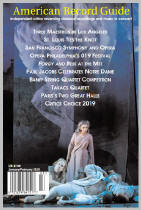Texte paru dans: / Appeared in: |
|
|
Outil de traduction ~ (Très approximatif) |
|
|
Reviewer: Mark
L. Lehman
Aurelio Bonelli (c1569-after
1620) was from Bologna, working as both a composer and a painter. This small
collection of pieces was printed in Venice in 1602. Not knowing the
composer’s identity, a listener might guess that these are by one of the
Gabrielis. Most of the compositions are four-part counterpoint, with points
of imitation. They could be played either by a keyboardist or an ensemble.
Four of them are eight-part pieces, and Federico del Sordo recorded those in
two sessions to simulate the use of two antiphonally-placed organs. He
blended those recordings together in an editing studio. Del Sordo’s liner
notes claim that someone else produced an edited score of some pieces, and
then he himself edited the rest of them for publication. This recording is
complementary to those books, helping to publicize the work of this
interesting composer. For the recording, Del Sordo did almost everything
himself: he made his edition; performed, engineered, and produced the
recordings; wrote the notes, and even took the photographs. He played organ
for 12 pieces, harpsichord for 6, and clavichord for the other 2. There
seems to be no compelling reason to choose one instrument over another,
other than variety in the program. The harpsichord and clavichord have
drifted out of tune a little bit for one piece each near the end.
The organ is in Umbria, built
in 1680. It belongs to a Benedictine convent. It has eight stops and it is
tuned in 1/6 comma meantone. Its pedalboard has only nine notes, and there
is not much occasion to use it in these pieces. Del Sordo plays this with
brisk articulation and fast tempos. He sounds better at organ and clavichord
than harpsichord, where he could bring more expressive range to his timing
and releases of the notes. The brief remarks about this harpsichord in the
essay suggest that its unusual tone comes from the use of iron strings
(instead of any brass). I suspect most of the cause of that tone is
different. Its plucking point is so far from the end of the string that this
sounds more like a virginal than a typical harpsichord. I’d like to hear
more from Del Sordo, perhaps playing some of Christian Erbach’s organ
music—contemporary with and similar to this. | |
|
|
|
|
Cliquez l'un ou l'autre
bouton pour découvrir bien d'autres critiques de CD |
|




